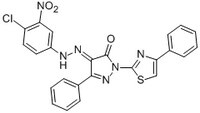530796 Sigma-AldrichTNF-TNFR Interaction Modulator, C87 - CAS 332420-90-3 - Calbiochem
Inhibits TNFα/β-stimulated biological activity by modulating, but not abolishing, TNF-TNFR interaction via direct TNF affinity interaction (KD = 110 nM).
More>> Inhibits TNFα/β-stimulated biological activity by modulating, but not abolishing, TNF-TNFR interaction via direct TNF affinity interaction (KD = 110 nM). Less<<Synonyms: (E)-4-(2-(4-Chloro-3-nitrophenyl)hydrazono)-3-phenyl-1-(4-phenylthiazol-2-yl)-1H-pyrazol-5(4H)-one, (E)-4-(2-(4-Chloro-3-nitrophenyl)), TNF-TNFR Signaling Inhibitor IV
Recommended Products
Overview
| Replacement Information |
|---|
Key Specifications Table
| CAS # | Empirical Formula |
|---|---|
| 332420-90-3 | C₂₄H₁₅ClN₆O₃S |
Pricing & Availability
| Catalog Number | Availability | Packaging | Qty/Pack | Price | Quantity | |
|---|---|---|---|---|---|---|
| 5.30796.0001 |
|
Glass bottle | 10 mg |
|
— |
| Description | |
|---|---|
| Overview | A phenylhydrazonodihydropyrazolone compound that inhibits TNFα/β-stimulated biological activity by modulating, but not abolishing, TNF-TNFR interaction via direct TNF affinity interaction (KD = 110 nM). Shown to prevent murine L929 cell death following hTNFα/β (1 ng/mL; Cat. Nos. 654205 & 654215) and actinomycin D (1 µg/mL; Cat. Nos. 114666 & 2472-OP) treatment (EC50 = 8.73 µM) by blocking TNF/ActD-induced caspase-3/8 cleavages & IκBα degradation without affecting Fas- (CD95) mediated Jurkat cell death or VP-16 (Etoposide; Cat. No. 341205) and ADR (Adriamycin/Doxorubicin; Cat. No. 324380) cytotoxicity in L292 cultures. When applied prior to D-galactosamine (1.2 g D-GalN/kg, Cat. No. 34539) & Lipopolysaccharide (LPS; 50 µg/kg) injection, C87 effectively prevents D-GalN/LPS-induced upregulation of plasma alanine transaminase & aspartate transaminase (ALT & AST) activity, resulting in significantly reduced liver damage and much improved survival rate (3X 12.5 mg C87/kg i.p. dosings 16, 8, & 1 h prior to D-GalN/LPS injection) in a murine hepatitis model in vivo. |
| Catalogue Number | 530796 |
| Brand Family | Calbiochem® |
| Synonyms | (E)-4-(2-(4-Chloro-3-nitrophenyl)hydrazono)-3-phenyl-1-(4-phenylthiazol-2-yl)-1H-pyrazol-5(4H)-one, (E)-4-(2-(4-Chloro-3-nitrophenyl)), TNF-TNFR Signaling Inhibitor IV |
| References | |
|---|---|
| References | Ma, L., et al. 2014. J. Biol. Chem. 289, 12457. |
| Product Information | |
|---|---|
| CAS number | 332420-90-3 |
| Form | Dark red solid |
| Hill Formula | C₂₄H₁₅ClN₆O₃S |
| Chemical formula | C₂₄H₁₅ClN₆O₃S |
| Reversible | Y |
| Quality Level | MQ100 |
| Applications |
|---|
| Biological Information | |
|---|---|
| Primary Target | TNFα |
| Primary Target K<sub>i</sub> | 110 nM for hTNF&alpha |
| Purity | ≥97% by HPLC |
| Physicochemical Information | |
|---|---|
| Cell permeable | Y |
| Dimensions |
|---|
| Materials Information |
|---|
| Toxicological Information |
|---|
| Safety Information according to GHS |
|---|
| Safety Information |
|---|
| Product Usage Statements |
|---|
| Packaging Information | |
|---|---|
| Packaged under inert gas | Packaged under inert gas |
| Transport Information |
|---|
| Supplemental Information |
|---|
| Specifications |
|---|
| Global Trade Item Number | |
|---|---|
| Catalog Number | GTIN |
| 5.30796.0001 | 04055977242973 |
Documentation
TNF-TNFR Interaction Modulator, C87 - CAS 332420-90-3 - Calbiochem SDS
| Title |
|---|
References
| Reference overview |
|---|
| Ma, L., et al. 2014. J. Biol. Chem. 289, 12457. |
| Data Sheet | ||||||||||||||||||||||||||||
|---|---|---|---|---|---|---|---|---|---|---|---|---|---|---|---|---|---|---|---|---|---|---|---|---|---|---|---|---|
|
Note that this data sheet is not lot-specific and is representative of the current specifications for this product. Please consult the vial label and the certificate of analysis for information on specific lots. Also note that shipping conditions may differ from storage conditions.
|







